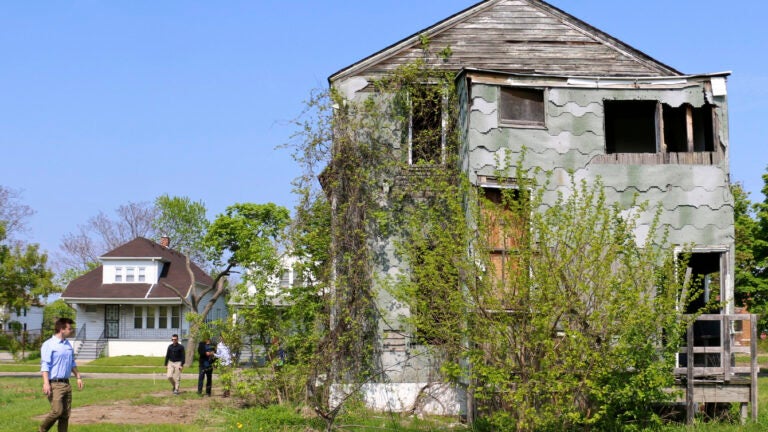
Students explore the area around an abandoned home. (USC Photo/Michael Thom)
USC Price undergrads set sights on Detroit’s revival
Students specializing in land use, transit, policy and social innovation take on a big task
An undergraduate class at the USC Price School of Public Policy spent a week in Detroit to help tackle what many consider to be the most monumental urban revitalization challenge in America.
Perhaps no metropolitan area in the country has faced as many problems as the Motor City. But where many see urban decay, planners and policy analysts see opportunity.
It wasn’t as doomsday as I assumed it would be from media depictions — there really seems to be a lot of forward momentum in the city.
Tay Vaughn
Assistant Professor Michael Thom led the undergraduate class to venture outside California so that students could witness firsthand the decline of a once-great city and the efforts being made to turn it around.
In 1950, with the big three automakers thriving, Motown was the fifth-largest city in the United States. Today, more than 40 of its 139 square miles are empty, an estimated 90,000 houses are abandoned, the unemployment rate is twice the national average and half the children live below the poverty line.
Last year, the city became the largest municipality in U.S. history to enter Chapter 9 bankruptcy.
“Detroit’s revitalization depends on expertise from all of Price’s areas of specialty — land use, transit, policy and social innovation,” Thom said. “Developing a class there for Price students was a match made in heaven.”
Joining Thom to oversee the trip were Associate Dean of External Affairs John Sonego and Associate Professor Liz Falletta.
A walking tour of downtown
Partnering with Detroit Future City, a project launched by then-mayor Dave Bing in 2010 to transform the city over the next 50 years, the students produced comprehensive capstone reports on four areas requested by the organization: public transit, education, how nonprofits can better work together and ways to handle all the vacant land.
During their visit, the class took a walking tour of downtown (where they stayed), bus tours to the outskirts of the city and surrounding suburbs, and met with leaders of foundations and developmental groups that are working on improving the area.
“It wasn’t as doomsday as I assumed it would be from media depictions — there really seems to be a lot of forward momentum in the city,” said junior Tay Vaughn. “When we talked to the locals, I was curious if they thought this was a turning point or another blip of positivity. Almost everyone seemed optimistic that the multitude of things happening now really will be looked back upon as the point when things changed for the better.”
Finding common ground
The 20 students broke into four groups to develop solutions for the areas of need outlined by Detroit Future City.
One group researched the organizations and stakeholders trying to make an impact in Detroit to find common ground where they could help each other; they focused particularly on bridging the gap between the nonprofits and businesses leading the city’s revival.
One suggestion was that online retail lender Quicken Loans, which along with owner Dan Gilbert (who also owns the NBA’s Cleveland Cavaliers) has made tremendous investment into downtown, could provide office space and financial support for Detroit SOUP, a monthly dinner funding micro-grants for creative projects in the city.
The land-use team offered its vision of a private conservancy being the best option for buying up, rehabilitating and determining optimal use for the city’s empty spaces. The group met with leadership from the Detroit Land Bank Authority, which could offer the conservancy an initial contribution of vacant land to get it started.
Future service planning
Another report outlined Detroit’s existing transportation conditions and a series of goals that the Detroit Department of Transportation should pursue. These included refocusing on basic service provision and high-demand routes, coordinating with the Suburban Mobility Authority for Regional Transportation to eliminate redundant stops and routes, and ensuring future service planning is coordinated with new transportation projects and revisions to the city’s master plan.
The group concentrating on education found that there are many technical training programs being offered by automobile makers, machine shops and the city, but that there’s no coordination of the efforts and that many people don’t know of the opportunities.
The student reports will be sent to Detroit Future City to contribute to a document the organization is putting together to advise a master plan being prepared by the city. The course was such a success that Thom intends to take another class to Detroit next spring or summer.
“To be able to apply everything we’ve been learning in the classroom and see how our education can make a difference was really great,” said senior Mimi Hefner. “It felt like I was playing a role, and the thoughts I had were important. I left Detroit thinking I might go back there, pitch tent for a couple years and help them out.”
